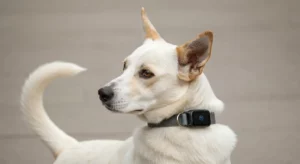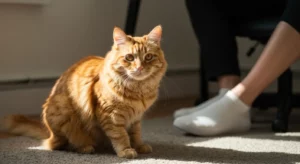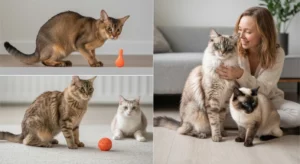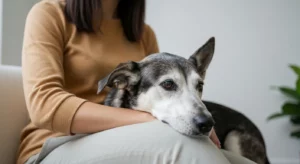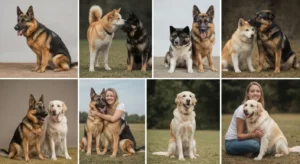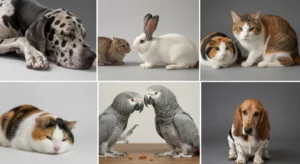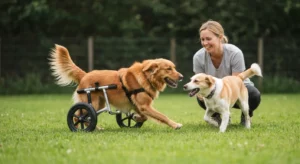Over my fifteen years working as a vet tech, a shelter volunteer, and a foster parent to more creatures than I can count, I’ve heard one question more than any other: “Will they get along?” It’s a question loaded with hope and anxiety. We dream of a harmonious, multi-species household, a real-life Disney movie unfolding in our living rooms. But we also fear the opposite: chaos, vet bills, and heartbreak.
The truth is, there’s no simple chart or formula. I’ve seen bonded littermates who couldn’t stand each other and I’ve seen predator and prey nap together in a sunbeam. What I’ve learned is that while species stereotypes hold a kernel of truth, personality, patience, and proper introductions are what truly forge the most incredible, unexpected friendships. These aren’t just theories; these are stories etched into my heart, from my own home and the rescue centers I’ve called a second home.
So, forget what you think you know. Let me tell you about some of the most surprising pairs I’ve ever had the privilege of knowing. These are the stories that remind me that love, in its purest form, knows no species.
-
The Gentle Giant and the Feline Overlord: A Great Dane and a Calico Cat
My journey into unlikely friendships started with Bartholomew, a goofy, hundred-and-fifty-pound Great Dane I adopted, and Jasper, a five-pound calico cat who had ruled my apartment with an iron paw for years. I was terrified. Bartholomew wasn’t aggressive, but he was a walking earthquake, all clumsy limbs and happy tail-wags. Jasper was… well, Jasper was a cat. A proud, territorial, and deeply skeptical cat.
The first week was a masterclass in management. I used baby gates to create separate zones, fed them on opposite sides of a closed door, and swapped their bedding so they could get used to each other’s scent. Jasper would sit on the far side of the gate, tail twitching, hissing softly whenever Bartholomew’s curious, wet nose got too close. My heart sank a little each time.
The breakthrough came on a rainy Tuesday. I was on the floor, trying to teach Bartholomew a “gentle” command with treats. He was failing spectacularly, drooling all over my hand. Suddenly, Jasper hopped the gate. He didn’t hiss. He walked slowly, deliberately, right up to Bartholomew’s massive head, which was resting on the floor in defeat. I held my breath. Jasper sniffed the Great Dane’s ear, then head-butted his giant snoot with a force that was surprisingly firm. Bartholomew’s eyes went wide. He didn’t move a muscle. From that day on, Jasper was the undisputed boss, and Bartholomew was his willing, adoring subject. I’d often find them napping together, with Jasper curled up in the curve of Bartholomew’s belly, a tiny, colorful queen on her gentle, speckled throne.
What this taught me: Slow, scent-based introductions are everything. Don’t force it. Let the smaller, more vulnerable animal set the pace. And sometimes, a big, goofy personality is exactly what a bossy little animal needs to feel secure. They weren’t just two pets that get along; they were family.
-
The Zen Master and the Curious Predator: A Flemish Giant Rabbit and a Former Stray Cat
Fostering a rabbit was new territory for me, especially since I had a cat, Luna, a sleek black cat I’d rescued from the street. Luna had a strong prey drive; I’d seen her stalk dust bunnies with lethal intensity. So when a Flemish Giant rabbit named Clover, who weighed a solid fifteen pounds, needed a temporary home, my answer was a hesitant “yes.”
The key, I knew, was creating an environment where the rabbit felt completely secure. Clover had his own large, reinforced pen in the living room. Luna was allowed to observe him from a distance, but never to approach the pen directly. She would watch, fascinated, as this giant, fluffy creature munched on hay, completely unbothered by her presence. Clover was the most laid-back animal I had ever met. Nothing fazed him. He was pure zen.
After a few weeks of observation, I decided to try a carefully supervised meeting on neutral ground. I sat on the floor with a handful of parsley for Clover and some treats for Luna. Clover hopped out and started exploring, and Luna approached cautiously. She got close, sniffed him, and then… she tried to do a classic cat-play pounce. Before I could intervene, Clover simply turned, sat up on his haunches, stared her down, and thumped his powerful back leg on the floor. THUMP! It was so loud and assertive that Luna literally jumped back, startled. She looked at me, then back at the rabbit, as if to say, “Did you see that?” She never tried to pounce on him again. Instead, they developed a quiet companionship, often sitting a few feet apart, just enjoying each other’s calm energy.
My Takeaway: With a prey/predator pairing, safety is the absolute priority. Never, ever leave them unsupervised, no matter how well they seem to get along. A confident, large rabbit and a curious, respectful cat can coexist, but it’s a delicate balance that relies entirely on the owner’s diligence and the animals’ specific personalities.
-
The Brains and the Brawn: An African Grey Parrot and a Golden Retriever
This pair wasn’t mine, but one I witnessed regularly at the home of a long-time vet clinic client. She had an African Grey parrot named Merlin and a Golden Retriever named Gus. If you’re thinking about pets that get along, a bird and a dog are high on the “probably not” list. But this was different.
Merlin was brilliant, with the vocabulary of a toddler and the mischievous mind of a supervillain. Gus was your typical Golden: sweet, loyal, and not exactly the sharpest tool in the shed. Merlin had his large cage in the living room, and Gus adored him. The client told me the story of how their bond formed. Merlin would drop pieces of his food out of the cage, and Gus, ever the opportunist, would gently gobble them up. This evolved into a game.
Merlin would say, in a perfect imitation of his owner’s voice, “Gus, you want a snack?” Gus’s tail would start thumping against the floor. Then, Merlin would carefully drop a piece of almond or a blueberry onto the floor below. Gus would gently take it and look up, waiting for the next one. The most hilarious part was that Merlin had also taught himself to mimic the doorbell. He’d ring the “doorbell,” watch Gus fly up and start barking, and then cackle with what I can only describe as pure, unadulterated parrot glee. Gus never seemed to mind being the butt of the joke. He was just happy to be part of Merlin’s world.
What I Learned: Intelligence in one animal and good nature in another can create a surprisingly symbiotic relationship. The key here was that Gus showed zero prey drive towards Merlin, and Merlin was never physically vulnerable to Gus. It was a relationship built on bribery and good-natured teasing.
-
The Odd Couple’s Office Hours: A Guinea Pig and a Senior Basset Hound
When my old Basset Hound, Barnaby, entered his golden years, his world became very small. He slept most of the day, his long ears collecting dust bunnies under the couch. Around the same time, I took in a feisty Abyssinian guinea pig named Pip. Pip was bold and chatty, full of wheeks and chirps, and needed more stimulation than his enclosure could provide.
I decided to set up a large, secure playpen for Pip on the living room floor for his “floor time.” Barnaby, roused from a nap by the curious squeaks, ambled over. His face was a perfect mask of droopy confusion. He laid down with a heavy sigh right next to the playpen fence, his nose pressed against the bars. Pip, far from being scared, scurried right up and started chattering at him through the wire.
This became their daily ritual. For an hour every evening, Pip would run his laps and Barnaby would serve as his sleepy, droopy-faced audience. Eventually, I felt comfortable enough to let Pip out with Barnaby under my hawk-like gaze. Pip would popcorn around Barnaby’s paws and sometimes even try to burrow into the folds of his neck. Barnaby would just lie there, occasionally opening one eye and giving a gentle tail wag. It was as if the little pig’s vibrant energy gave my old dog a new sense of purpose.
My Takeaway: A calm, gentle, and elderly dog can make a wonderful companion for a small animal, *under 100% supervision*. The energy levels matched in an inverse way—Pip’s high energy was entertaining for the low-energy Barnaby. This is one of those pairings that requires immense trust in your dog and constant vigilance.
-
The Unlikeliest Cuddle Puddle: A Pair of Domestic Rats and a Grumpy Cat
I know what you’re thinking. Cats and rats? Absolutely not. And I would have agreed with you before I met Pesto and Linguini. I was fostering two male domestic rats for a friend who was moving. They were intelligent, clean, and surprisingly affectionate. My resident grump, a ginger tabby named Marmalade who tolerated no fools, was my biggest concern.
The rats lived in a multi-level “Critter Nation” cage that was Fort Knox-secure. For weeks, Marmalade completely ignored it. Then, one day, I saw him sitting near the cage, watching them. Not in a hungry way, but in a curious way. The rats, completely unafraid, would come to the bars and sniff in his direction.
The real magic happened by accident. I had one of the rats, Pesto, out on my shoulder while I was sitting on the couch. Marmalade jumped up and settled on my other side. My body was a buffer zone. Pesto, being a brave little soul, crawled down my arm and right up to Marmalade’s tail. Marmalade’s tail twitched. He turned his head, looked at the rat, looked at me, and then… let out a long, dramatic sigh and laid his head down. Pesto proceeded to *groom* the tip of Marmalade’s tail. From then on, during supervised playtime, the rats would often groom Marmalade’s fur, and he would purr. He never once showed aggression, only a sort of weary acceptance that morphed into genuine affection.
What This Taught Me: Domestic rats are not wild rats. They are smart, social animals that can defy expectations. This pairing worked because Marmalade’s prey drive was surprisingly low and the rats were confident and socialized. It shattered my own biases and showed me that even the most “classic” enemies can find common ground.
-
The Farmyard Bromance: A Pygmy Goat and a Blue Heeler Mix
A few years ago, I helped out at a small hobby farm rescue, and that’s where I met Buck, a young Pygmy goat who was surrendered after his owners realized they weren’t prepared for his boundless energy. He was lonely and mischievous. The rescue also had Dash, a Blue Heeler mix with an intense herding instinct but a gentle soul.
We were worried Dash would try to herd Buck too intensely, but something amazing happened. Buck didn’t act like prey. He acted like another dog. When Dash would try to circle him, Buck would lower his head and playfully butt him. It immediately turned into a game of chase. They would race around the pasture for hours, Dash nipping playfully at Buck’s heels and Buck leaping onto hay bales to gain the high ground.
Their bond was undeniable. They were inseparable. If we took Dash for a walk, Buck would cry at the fence line until he returned. If Buck was getting his hooves trimmed, Dash would sit nearby, whining with concern. They weren’t just a dog and a goat living in the same space; they were best friends who spoke their own unique language of play. They were the perfect outlet for each other’s energy.
My Takeaway: For high-energy working dogs, a non-traditional “pet” like a goat can sometimes be a better playmate than another dog. The key was that both had a “play” mindset. This is a testament to how animals can adapt their innate behaviors (herding, sparring) into a shared game when they find the right partner.
-
The Backyard Standoff: A Bossy Hen and a Patient Tabby Cat
My final story comes from my own backyard, where I keep a small flock of chickens. Most of my cats have always given the chickens a wide berth, but one of my younger tabbies, Oliver, was endlessly curious. And one of my hens, a big Rhode Island Red I called Meryl Streep (because she was so dramatic), was the undisputed flock leader.
The first time Oliver ventured too close to the coop, Meryl marched right out, fluffed up her feathers to twice her normal size, and charged him. Oliver, who had probably envisioned an easy snack, was so shocked he literally scrambled backward and fled. This happened two more times. After the third “talking to” from Meryl, Oliver’s approach changed. He would lie down in the grass about twenty feet away and just watch them. He seemed to understand that Meryl was in charge.
A strange, respectful truce was formed. Meryl and her flock would forage, and Oliver would “supervise” from his sunny spot. He never stalked them again. The most touching moment came when I found Meryl dust-bathing near the patio, and Oliver was sleeping peacefully just a few feet away, both of them soaking up the afternoon sun. There was no fear, just a quiet understanding. The hen had taught the cat some respect, and the cat had learned his lesson.
What I Learned: Sometimes, the “prey” animal can be the one to lay down the law. A confident, brave chicken can absolutely hold her own. It taught me that animals establish their own social hierarchies, and if we allow them to communicate (safely!), they often sort things out in ways we could never predict.
Looking back on all these furry, feathery, and sometimes scaly friendships, the common thread is always patience. It’s about seeing animals as individuals, not just species. It’s about creating safe spaces, managing introductions with painstaking care, and having a deep respect for their instincts. If you open your heart and your home, you might just be lucky enough to witness one of these impossible, beautiful friendships bloom right before your eyes.




